林果业(树林、园林、果木)作为农业产业结构的重要组成部分,是实现生态效益与经济效益协同发展的关键产业[1-3]。在林果生产全过程中,收获作业是最重要的环节,这一环节不仅具有显著的劳动密集型特征,还对季节性有较强的依赖性[4],据统计,规模化果园的劳动力投入占整个生产过程的35%~45%,其成本占比为50%~70%[5]。随着林果种植面积的不断扩大,人工收获成本的持续攀升已严重影响了林果产品的市场竞争力[6]。
目前,机械收获技术已在多个领域得到广泛应用并趋于成熟[7],特别是在种植规模大、果实形状规则且主要用于深加工的果品种类中,如苹果[8-9]、柑橘[10]、蓝莓[11-12]和葡萄[13-14]等,林果机械收获技术已取得显著成效。然而,对于鲜食类、质地柔软且易腐烂、种植模式多样、种植区域集中的水果(如榴莲、山竹和杧果),其机械收获技术仍面临重大挑战[15-16],这些水果因特殊的物理特性和种植条件,使得现有的林果机械收获技术难以广泛应用[17]。因此,亟须通过深入研究和创新来突破技术瓶颈,开发更高效、更智能的林果机械化收获系统。这将有助于降低生产成本、提升工作效率、增强市场竞争力,从而推动产业可持续发展,加快农业现代化进程。
为了更好地把握林果收获机械领域的研究现状、热点问题以及发展趋势,笔者在本研究中利用Citespace 软件[18-19]对Web of Science(WOS)检索平台Sci核心数据库中1994—2024年的文献进行计量和可视化分析。研究结果不仅有助于研究人员全面了解该领域的发展态势,还可为后续研究提供有价值的参考和借鉴,推动林果收获机械研究取得进展,促进该领域的持续创新与发展。
1 数据来源与研究方法
1.1 数据来源
文献数据样本来源于Web of Science检索平台,该平台是世界领先的引文数据库,其中包含全球最有影响力的期刊,包括开放访问的期刊以及会议录文献和书籍的论文记录[20]。基于CiteSpace 软件的可视化分析需求,制定了详细的文献检索策略(表1)。通过系统检索与筛选,最终获得有效文献838篇作为研究样本。所有数据的检索截止日期为2024 年9 月17 日。检定结果会因数据库更新而轻微改变,但数量变化不会对最终结论产生实质性影响。
表1 基于CiteSpace 林果收获机械的可视化分析检索式
Table 1 Visual analysis retrieval formula based on CiteSpace fruit harvesting machinery

主题Theme主题Title+abstract+keywords,TS和主题And TS年份Year文献类型Type of literature语言Language检索要求Retrieval requirements“水果”“fruit”“收割机”、“拾取机”、“收集机”、“振动”、“吸气”、“抓取”、“吹风”、“拾取”、“拾取”或“机器人”“Harvester”or“picking machine”or“collecting machine”or“vibration”or“air-suction”or“grasp”or“air blast”or“picking”or“pick-up”or”robot”1994—2024年In 1994—2024论文或综述论文Article or Review article英语English
1.2 研究方法
使用Citespace v6.1.6R与Origin等专业分析软件对检索文献进行系统性的可视化分析与数据处理。首先将筛选后的文献数据导出至预设的“input”文件夹,并依次分别命名为download_01、download_02,保存为txt文本格式,然后导入到Citespace v.6.1.6R进行除重和转换操作,具体参数设置详见表2。
表2 CiteSpace 应用设置
Table 2 CiteSpace application settings

类型Type时间跨度设置Time span setting节点类型选择Node type selection节点类型阈值Node type threshold系统默认值System default value系统默认值System default value系统默认值System default value修剪Pruning设置Setting 1“作者”/“国家”/“机构”/“关键词”“Author”/“Country”/“Institution”/“Keyword”“排名前N的节点”“TopN”“前N%的节点”“TopN%”“综合考量作者发表论文的数量以及论文的被引次数总和”“g-index”“寻经路径”、“修剪分割网络”和“修剪合并网络”“Pathfinder”,“Pruning sliced networks”and“Pruning the merged network”
基于上述研究方法,笔者在本研究中从发文量、作者、机构、国家及期刊等多个维度开展系统性数据分析。通过共现网络和密度图谱等可视化图像展现,深入探究了各知识单元间的相似性测度与相互关系。在此基础上,进一步识别了研究领域的关键发展路径与知识拐点,并对未来研究趋势、热点领域及学术前沿进行科学预测与展望。
2 结果与分析
2.1 发文量及年度变化
年度发文量可以反映该领域受关注程度的变化情况,是评定科研发展的一项重要指标[21]。基于Excel、Origin 软件,根据样本数据绘制出1994—2024年林果收获机械领域的相关研究年度发文量统计图,如图1所示。
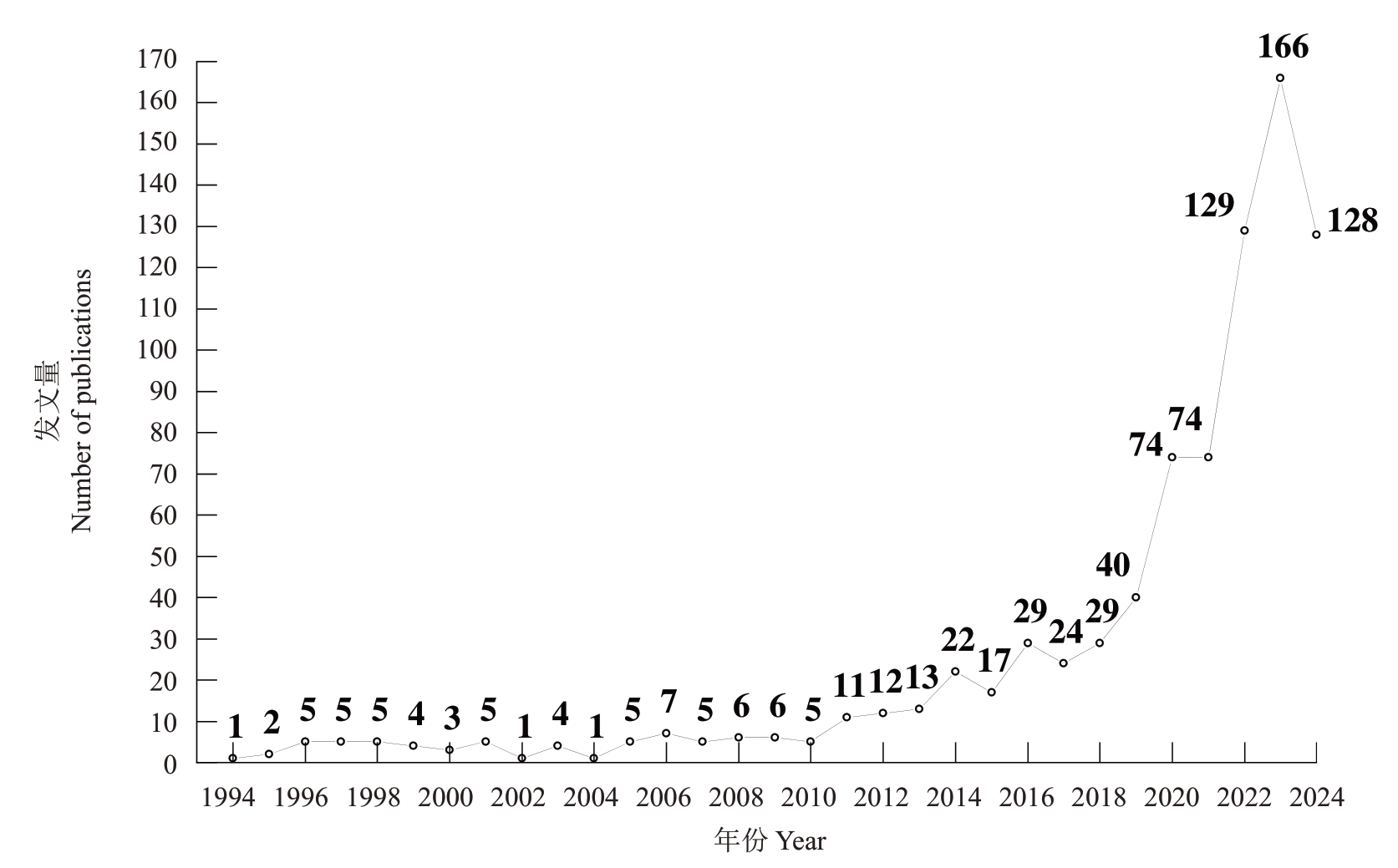
图1 1994—2024 年林果收获机械领域发文量
Fig.1 Number of papers published in the field of fruit harvesting machinery during 1994 to 2024
由图1 可知,林果收获机械领域研究发文量整体呈现上升趋势。2023 年发文数量较1994 年增加了165篇,增长率为16 500%。基于发文量变化趋势分析,林果收获机械研究发展历程可划分为3 个特征显著的阶段:第一阶段(1994—2010 年)为发展初期,年发文量在0~10 篇区间波动,其原因为这一时期的研究相对有限,农业机械化重点集中于耕整等基础作业领域,而林果收获机械尚处于探索阶段。电子技术与自动化技术的突破为该领域带来了新的发展契机。此阶段的研究成果主要体现在简单电子控制系统的应用上,这些系统实现了机械摇晃、采摘等基础操作的自动化[22-23],显著提升了采摘的精度和效率,同时降低了对果实与果树的损伤。第二阶段(2011—2018年)呈现稳定增长态势,随着劳动力成本的持续攀升促使传统手工采摘模式面临挑战,大规模果园的种植和管理迫切需要更高效的采摘设备,以提高生产效率和经济效益。这一阶段的研究重点聚焦于机械结构的优化与创新,如在苹果采摘领域,摇动捕捉法、机器人辅助平台等技术取得了显著进展[24],技术创新与市场需求的双重驱动,有力推动了林果收获机械研究的深入发展。第三阶段(2019—2024 年)标志着该领域的重大转折,年发文量爆发式增长,累计达571篇,增速显著高于前一阶段。这一快速发展得益于多方面因素的共同作用:林果产业规模不断扩大、机械技术突破性进展以及政府的有力扶持。特别是计算机视觉技术[25-27]、传感器技术[28-30]和人工智能技术[31-33]等技术的快速发展,使收获机械能够通过三维检测[34-35]和图像识别算法[36]等技术手段,可以精准地识别果实的位置、大小和成熟度,实现智能化精准采摘。这些技术进步不仅大幅度提升了采摘质量和效率,还推动设备向市场化、社会化发展,为林果收获机械领域的可持续发展奠定了坚实基础。
2.2 主要研究国家/地区及机构分析
2.2.1 国家/地区 国家发文量是衡量其在特定研究领域活跃程度的重要指标。笔者在本研究中通过构建国家合作网络图(图2),系统分析了林果收获机械领域具有影响力的国家/地区及其合作网络特征。在该可视化网络中,节点代表发文国家,其大小与发文量成正比;节点间的连线则表示国家间的科研合作关系。分析结果显示,该合作网络共包含56个节点和48条连线,网络密度为0.031 2。这一结构特征表明:(1)全球共有56 个国家参与了林果收获机械领域的研究,其中亚洲、欧洲和北美构成了主要研究区域,这一地理分布特征可能与国家政策导向、经济发展水平、农业产业基础以及适宜林果业发展的气候地理条件等因素密切相关[37]。(2)相对稀疏的合作网络(仅48 条连线)反映出当前国际科研合作尚不密切,学术交流有待加强,且未形成明显的核心主导国家。

图2 国家合作网络图
Fig.2 National cooperation network diagram
基于1994—2023 年国家层面的共现频次与中介中心性分析(图3),揭示了林果收获机械领域的国际研究格局。数据显示,发文量排名前三的国家分别是中国(523篇,占总量62.4%)、美国(114篇,占13.6%)和西班牙(43篇,占5.1%)。在中介中心性分析中,以≥0.1 作为关键节点的判定阈值,美国(0.82)、西班牙(0.54)、中国(0.38)、日本(0.20)和英国(0.20)均被识别为关键节点。这一结果表明,尽管部分国家的发文量相对较少,但其在林果收获机械研究领域仍具有重要影响力。
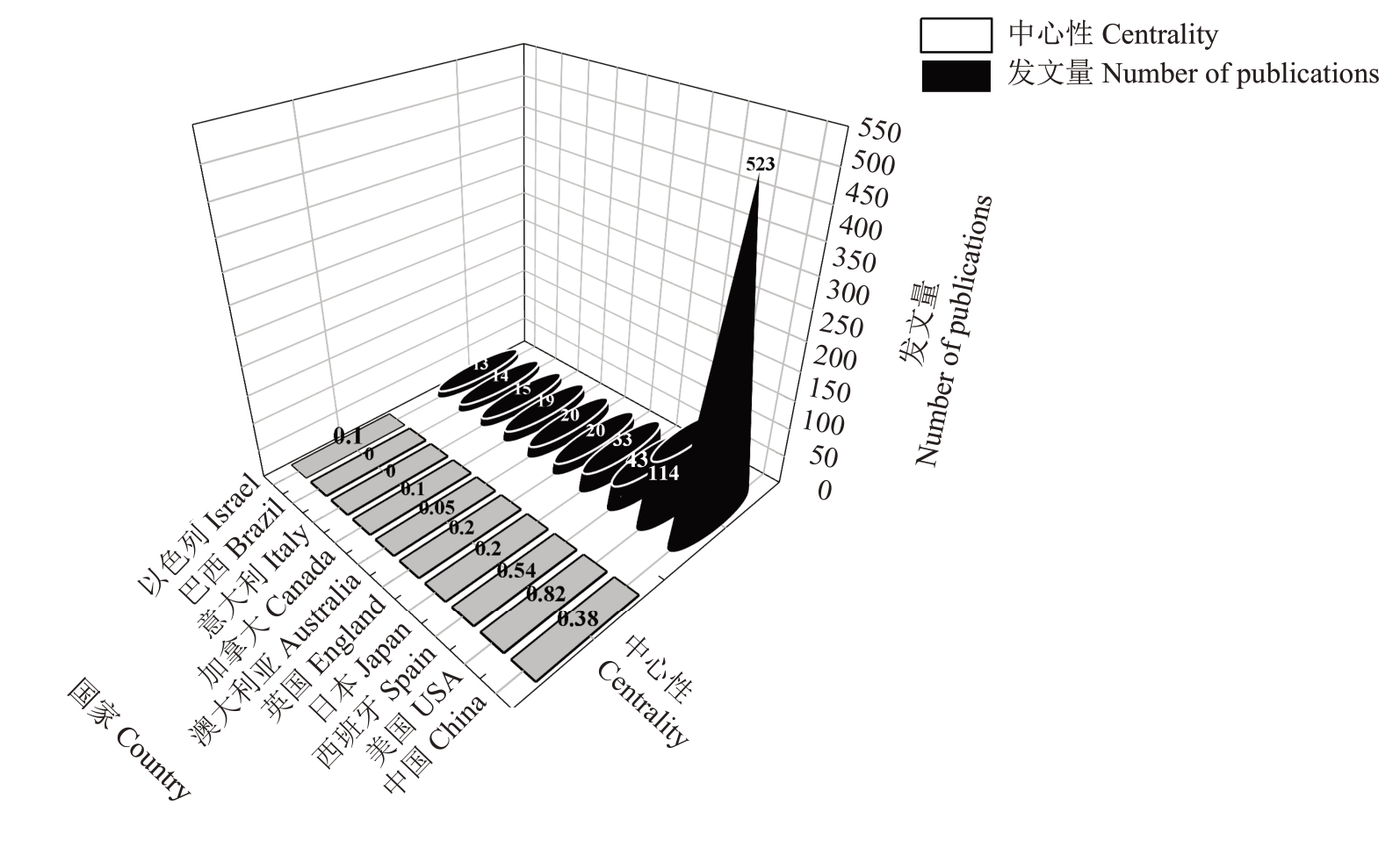
图3 林果收获机械发文量TOP10 国家
Fig.3 The number of papers on fruit harvesting machinery TOP10 countries
值得注意的是,中国自20世纪90年代以来始终保持着全球林果种植面积和产量的领先地位,其发文量远超排名第二的美国400 余篇。然而,中国研究的中介中心性相对较低(0.38),这一现象值得国内学术界深入反思与重视,提示我们需要在提升研究质量和国际影响力方面做出更多努力。
2.2.2 研究机构及单位 研究机构的分布格局反映了林果收获机械领域科研力量的空间集聚特征。通过构建研究机构合作网络图(图4),可以直观展示各研究机构在该领域的学术产出及其合作网络。机构发文量不仅体现了其在该领域的研究投入程度,也反映了其持续性的科研努力与学术贡献。

图4 研究机构合作网络
Fig.4 Research institution cooperation network
1994—2024 年间,全球共有318 家研究机构参与林果收获机械领域研究,形成319 条合作连线。然而,这些连线普遍较细且颜色较浅,反映出机构间的合作密度和强度均显不足。
发文量前十的研究机构如图5 所示,其中中国占据6席,美国3席,西班牙1席。值得注意的是,这些机构多为高等院校,凸显了高校在该研究领域的主导地位和重要贡献。西北农林科技大学以61 篇发文量(占比7.28%)位居榜首,华南农业大学以59篇(7.04%)紧随其后。发文量前五的机构均来自中国,且其中介中心性均大于0.1,这不仅体现了这些机构强大的研究实力,也反映了其广泛的国际合作网络和显著的学术影响力。

图5 林果收获机械领域发文量TOP10 研究机构
Fig.5 TOP10 research institutions in the field of fruit harvesting machinery
中国研究机构的突出表现主要得益于以下几个因素:国家高度重视农业发展,制定并落实了一系列支持政策;持续加大对农机研发的投入力度,支持企业和科研机构开展技术创新和产品研发;在农业产业政策中将林果业机械化列为重点内容,鼓励各地在发展林果产业的同时提升机械化水平。国家通过整体规划和布局,明确了农业机械化发展的目标、任务和重点领域,为林果收获机械的智能化、高效化和精准化发展提供了有力的政策支持和宏观指导[38]。
2.3 作者合作网络共现分析
作者合作网络共现分析揭示了林果收获机械研究领域作者的学术贡献分布与合作关系。对作者合作网络进行可视化分析(图6),结果显示:该领域共有632名研究者参与,形成934条合作连线。这一网络结构特征表明,虽然已形成多个规模不等的研究团队,且团队内部合作较为紧密,但团队间的学术交流与合作仍显不足。
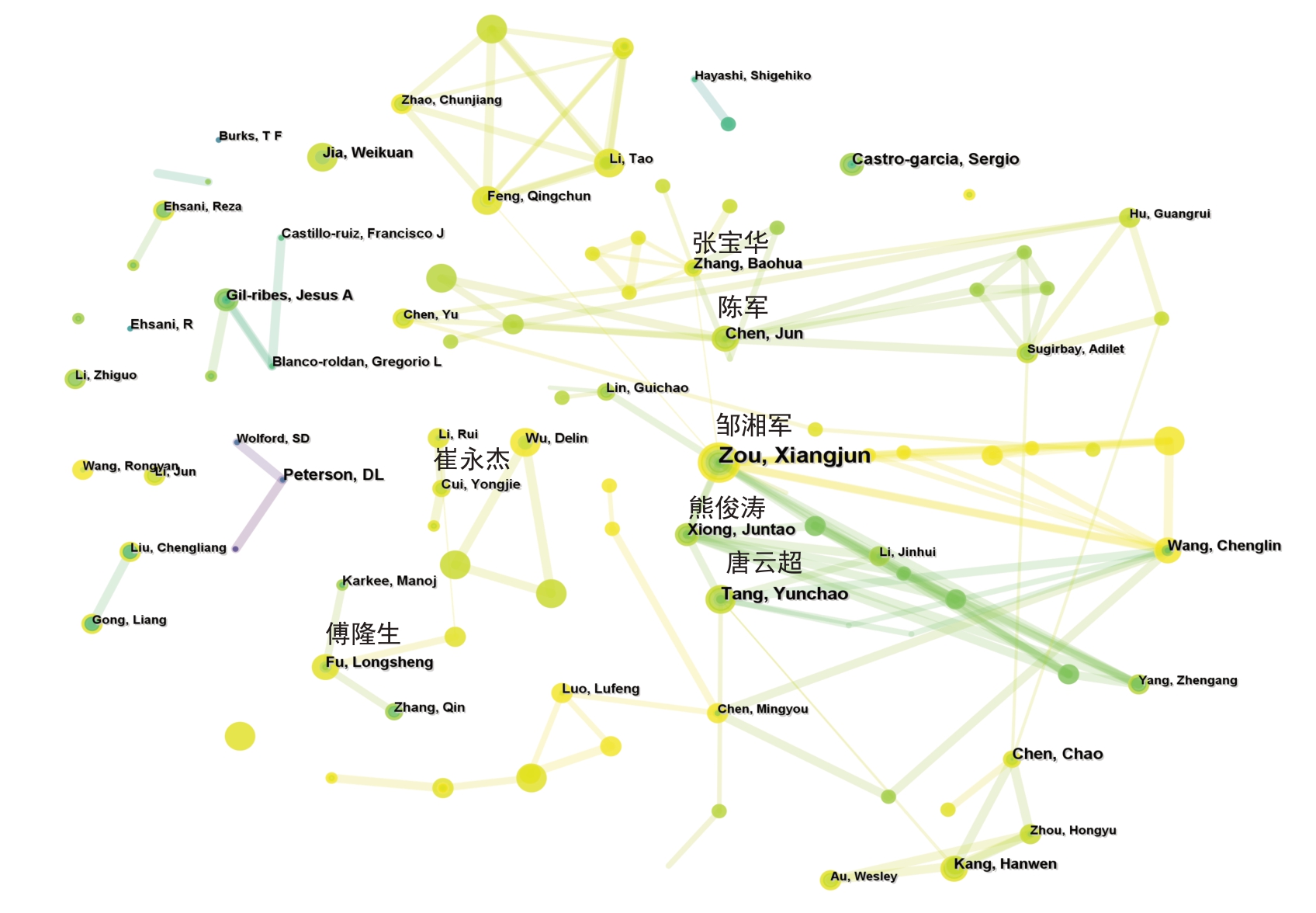
图6 林果收获机械领域作者合作网络
Fig.6 Author cooperation network in the field of fruit harvesting machinery
值得注意的是,由于数据库在作者姓名识别方面存在固有局限性(如全称与简写无法完全匹配,以及作者机构变动等因素),得出的分析结果可能存在一定偏差,仅能反映总体趋势。同地区研究者之间形成了密集的合作网络;跨国、跨地区的合作强度明显弱于地区内部合作,这反映出当前国际学术交流与合作仍有待加强。
发文量与中介中心性为评估研究者在特定领域的学术贡献和影响力提供了多维度的分析视角。根据可视化分析结果(图7),发文量排名前五的研究者分别为:ZOU X J(邹湘军)(25篇)、TANG Y C(唐云超)(13 篇)、Castro-garcia,Sergio(12 篇)、CHEN J(陈军)(12篇)、Peterson D L(10篇),其发文量占发文总量的8.6%;然而,值得注意的是,尽管这些研究者具有较高的学术产出,但其中介中心性均低于0.1。这一现象反映出两个重要特征:当前全球研究网络呈现出松散的结构特征,研究者之间的联系紧密度较低;学术交流与合作主要局限于小范围群体,整体影响力有待提升。这种分布格局暗示需要加强国际学术交流,促进更大范围的科研合作。
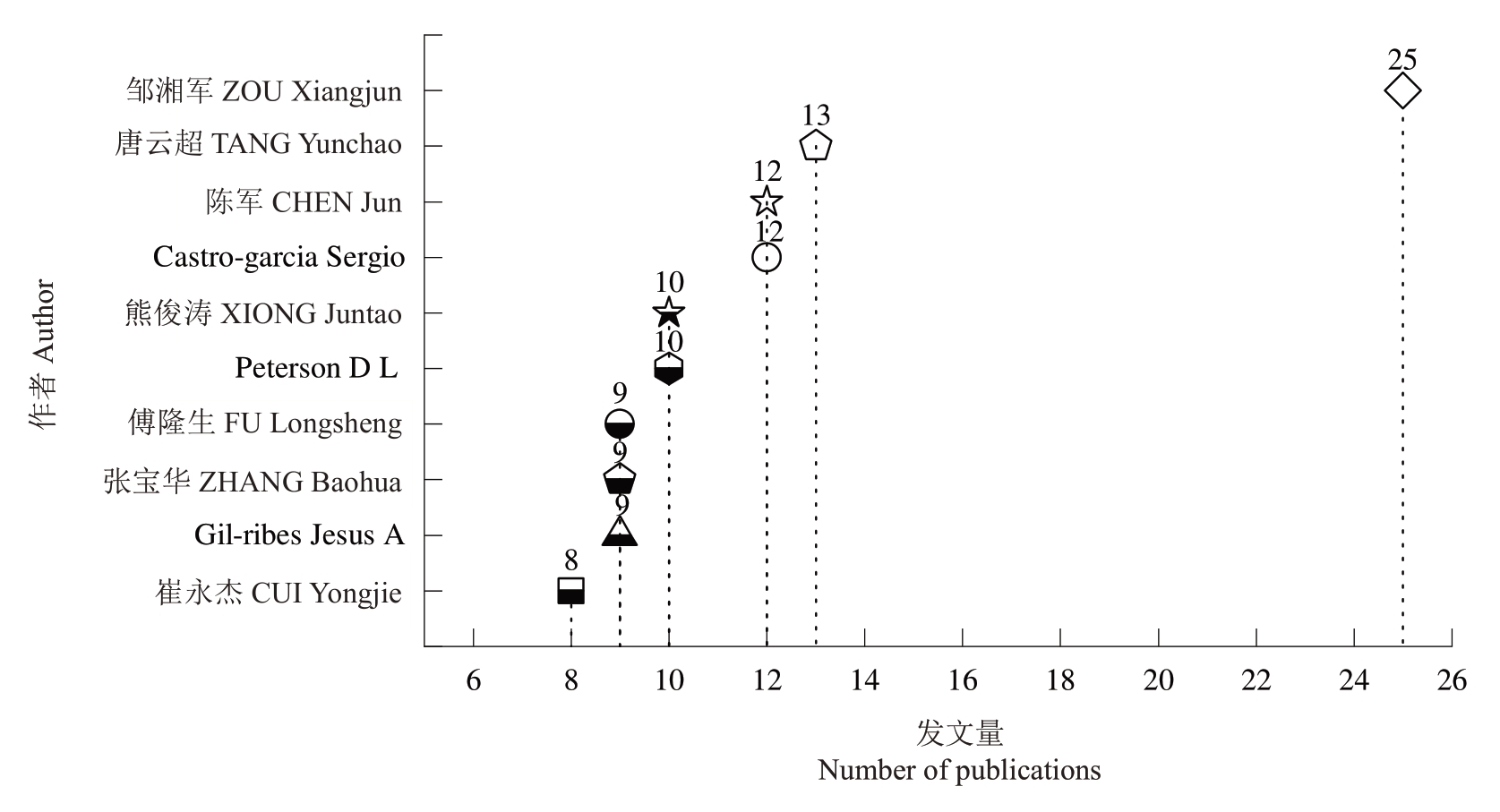
图7 林果收获机械领域发文量TOP10 作者
Fig.7 The number of papers published in the field of fruit harvesting machinery TOP10 author
发文量与篇均被引用次数是评估研究者在特定领域学术影响力的重要指标,能够有效反映其研究成果的认可度与贡献度。华南农业大学的ZOU X J(邹湘军)致力于机器视觉和图像处理应用于果实识别与定位、识别果实成熟度、机器避障等相关工作,发表相关文献25篇被引次数为1258次,篇均被引为50.32次,说明作者在该领域有较强影响力。
基于普赖斯定律(Price’s Law),通过分析领域内最高产作者的发文量及其在全体作者中的占比,评估了该领域核心作者团队的形成情况。这一方法为识别领域内的核心研究群体提供了量化依据。
式中:N为论文数量;Mmax=25/篇。
根据式(1)计算得出N≈4,纳入文献统计的作者共有632 人,发文量大于4 篇的核心作者有63人,占比K=9.97%(认定某领域具有核心作者群的条件:K 大于或等于全部论文数量的50%)。占比9.97%表明该研究领域核心作者团队还未形成[39-40]。
林果收获机械领域具有广阔发展空间。建议从两方面推进:加强学术交流,通过举办国际研讨会、学者访问和科研合作等,促进知识共享与协同创新;构建跨学科平台,整合计算机科学、自动化技术和农业工程等学科资源,打破学科壁垒,增强研究协同效应,推动领域向更深层次发展。
2.4 期刊发文量
期刊作为学术成果的主要载体,其分布特征分析对识别领域核心期刊、追踪研究动态具有重要参考价值[41]。表3 列出了林果收获机械领域发文量前十的期刊,其发文量均超过20 篇,其中期刊Computers and Electronics in Agriculture(农林科学1 区TOP期刊)以140 篇的发文量位居榜首,占比超16%,显著领先于其他期刊。这些期刊涵盖林业科学、生物学和计算机科学等多个学科,充分体现了林果收获机械研究的跨学科特性。因此,推动该领域发展需要加强各学科间合作与交流,积极探索新技术与新方法。
表3 林果收获机械领域发文量TOP10 期刊
Table 3 TOP10 journals in the field of fruit harvesting machinery

序号Number 1 2 3 4 5 6 7 8 9 10出版物标题Title of publication农业中的计算机和电子Computers and Electronics in Agriculture生物系统工程Biosystems Engineering农业-巴塞尔Agriculture-basel农学-巴塞尔Agronomy-Basel传感器Sensors农业应用工程Applied Engineering In Agriculture国际农业与生物工程杂志International Journal of Agricultural and Biological Engineering野外机器人学杂志Journal of Field Robotics植物科学前沿Frontiers in Plant Science美国农业与生物工程师学会会刊Transactions of the ASABE记录数Number of records 140 51 46 44 35 29 27 23 22 22影响因子(2023年)Impact factor(In 2023)7.7 4.4 3.3 3.3 3.4 0.8 2.2 4.2 4.1 1.4
3 研究热点与趋势
3.1 关键词共现分析
3.1.1 关键词合作网络分析 关键词作为反映研究主题与核心内容的重要指标,其频次与中心性分析可有效揭示领域研究热点与发展趋势[42]。图8展示了林果收获机械领域的关键词共现网络,包含567个关键词和1114 条合作连线,网络密度为0.006 9。其中,出现频次≥20 次的关键词有21 个,主要集中在采摘机[43]、捡拾机[44-45]、振动机[46-47]、采摘机器人[48-49]等研究方向。为提升林果收获机械的作业性能,相关研究人员在智能采摘机器人[50],视觉控制技术[51]、识别和定位[52-53],图像处理技术[54],末端执行器和机械臂[55-57]等领域开展了深入研究,致力于实现精准识别、快速响应、轻柔采摘、分类采收及复杂地形适应等目标。
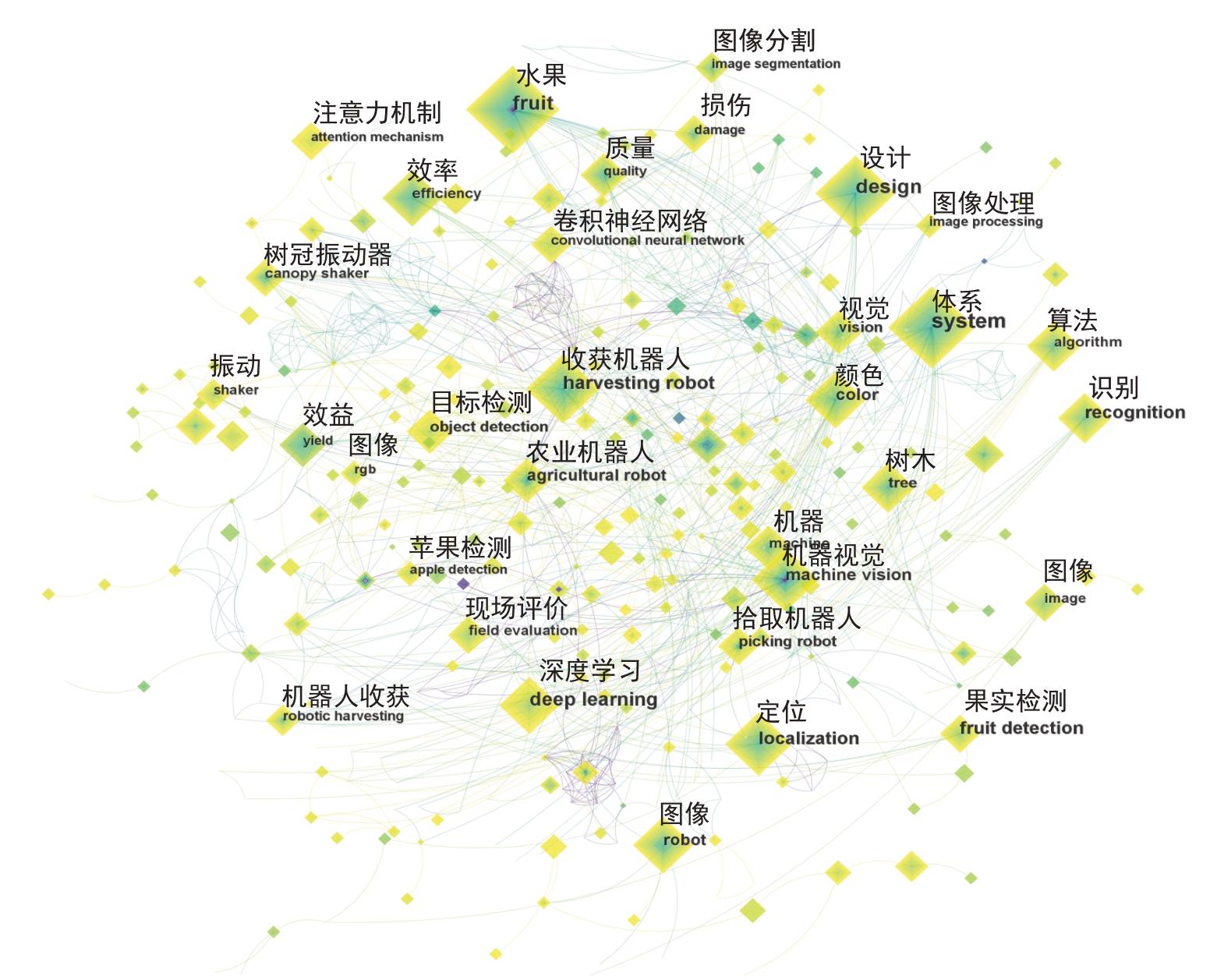
图8 林果收获机械领域关键词合作网络图
Fig.8 Keyword cooperation network diagram in the field of fruit harvesting machinery
根据上述统计关键词频率的分布,从林果种类、树形特征、收获方式及代表性技术等维度进行系统统计(表4、表5)。分析结果表明,林果种植模式的多样性、地形的复杂性、树形种类的丰富性以及果实物理特性的差异性,直接导致了收获方式的多样化。这种多样性进一步催生了种类繁多的林果收获机械,并推动了不同技术路径的发展,形成了各具特色的技术应用场景和技术特征。
表4 林果分类及收获方式
Table 4 fruit classification and harvesting methods
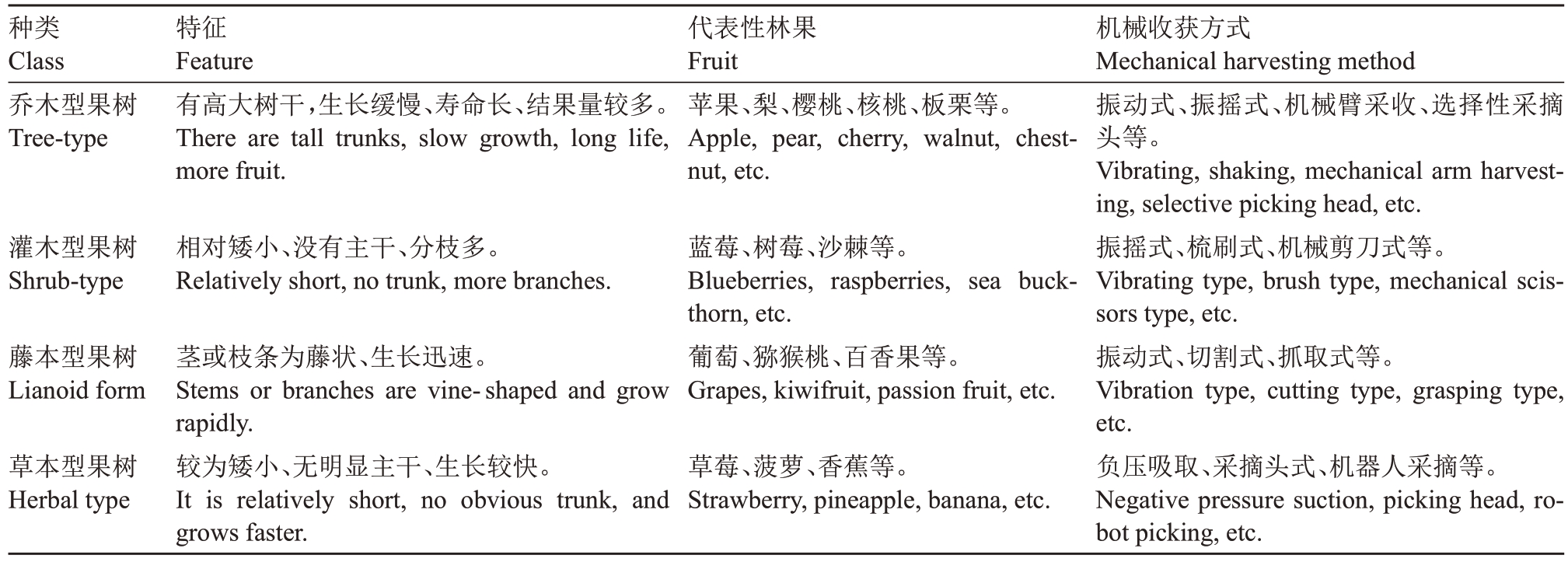
种类Class乔木型果树Tree-type特征Feature有高大树干,生长缓慢、寿命长、结果量较多。There are tall trunks, slow growth, long life,more fruit.代表性林果Fruit苹果、梨、樱桃、核桃、板栗等。Apple, pear, cherry, walnut, chestnut,etc.灌木型果树Shrub-type相对矮小、没有主干、分枝多。Relatively short,no trunk,more branches.藤本型果树Lianoid form蓝莓、树莓、沙棘等。Blueberries, raspberries, sea buckthorn,etc.葡萄、猕猴桃、百香果等。Grapes,kiwifruit,passion fruit,etc.草本型果树Herbal type茎或枝条为藤状、生长迅速。Stems or branches are vine-shaped and grow rapidly.较为矮小、无明显主干、生长较快。It is relatively short, no obvious trunk, and grows faster.草莓、菠萝、香蕉等。Strawberry,pineapple,banana,etc.机械收获方式Mechanical harvesting method振动式、振摇式、机械臂采收、选择性采摘头等。Ⅴibrating, shaking, mechanical arm harvesting,selective picking head,etc.振摇式、梳刷式、机械剪刀式等。Ⅴibrating type, brush type, mechanical scissors type,etc.振动式、切割式、抓取式等。Ⅴibration type, cutting type, grasping type,etc.负压吸取、采摘头式、机器人采摘等。Negative pressure suction, picking head, robot picking,etc.
表5 林果收获机械技术应用场景和技术特点
Table 5 Application scenarios and technical characteristics of fruit harvesting machinery technology
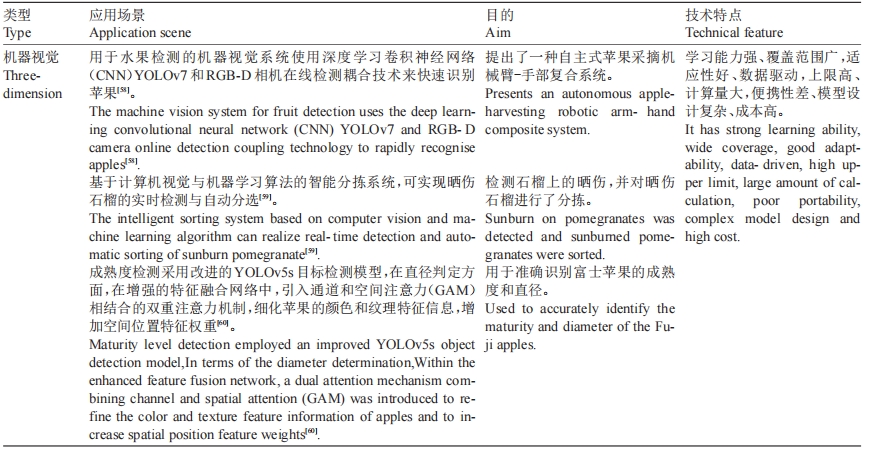
类型Type应用场景Application scene目的Aim技术特点Technical feature机器视觉Threedimension用于水果检测的机器视觉系统使用深度学习卷积神经网络(CNN)YOLOv7 和RGB-D 相机在线检测耦合技术来快速识别苹果[58]。The machine vision system for fruit detection uses the deep learning convolutional neural network (CNN) YOLOv7 and RGB-D camera online detection coupling technology to rapidly recognise apples[58].基于计算机视觉与机器学习算法的智能分拣系统,可实现晒伤石榴的实时检测与自动分选[59]。The intelligent sorting system based on computer vision and machine learning algorithm can realize real-time detection and automatic sorting of sunburn pomegranate[59].成熟度检测采用改进的YOLOv5s目标检测模型,在直径判定方面,在增强的特征融合网络中,引入通道和空间注意力(GAM)相结合的双重注意力机制,细化苹果的颜色和纹理特征信息,增加空间位置特征权重[60]。Maturity level detection employed an improved YOLOv5s object detection model,In terms of the diameter determination,Within the enhanced feature fusion network,a dual attention mechanism combining channel and spatial attention (GAM) was introduced to refine the color and texture feature information of apples and to increase spatial position feature weights[60].提出了一种自主式苹果采摘机械臂-手部复合系统。Presents an autonomous appleharvesting robotic arm- hand composite system.检测石榴上的晒伤,并对晒伤石榴进行了分拣。Sunburn on pomegranates was detected and sunburned pomegranates were sorted.用于准确识别富士苹果的成熟度和直径。Used to accurately identify the maturity and diameter of the Fuji apples.学习能力强、覆盖范围广,适应性好、数据驱动,上限高计算量大,便携性差、模型设计复杂、成本高。It has strong learning ability,wide coverage, good adaptability, data-driven, high upper limit, large amount of calculation, poor portability,complex model design and high cost.、
表5 (续) Table 5 (Continued)

?
3.1.2 关键词研究热点分析 关键词出现频次与中心性是识别研究热点的重要指标。高频关键词反映了领域研究焦点,而其中介中心性则表征了其在共现网络中的媒介作用强度,中心性越高,影响力越大。图9展示了林果收获机械领域词频前十的关键词[66-67],其中mechanical harvesting(153次,0.21)、machine vision(147 次,0.15)、design(115 次,0.12)和fruit(97次,0.22)等高频关键词的中心性均大于0.1,表明这些研究方向在领域内具有重要影响力。
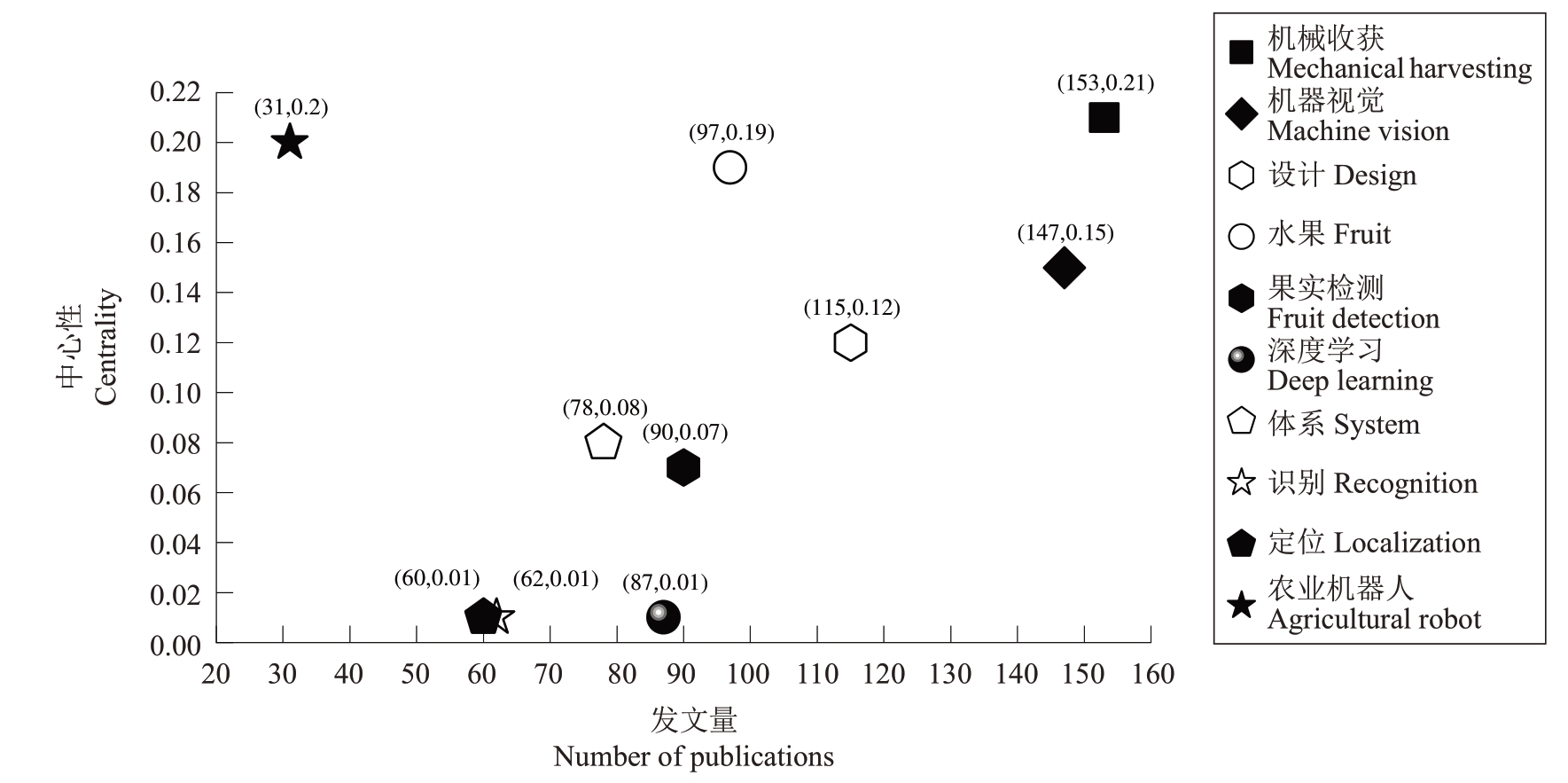
图9 林果收获机械领域词频TOP10 关键词
Fig.9 Keywords TOP10 in the field of fruit harvesting machinery
研究表明,机械收获、机器视觉和新型收获机设计创新是当前林果收获机械领域的研究热点。其中,“fruit detection”、“machine vision”、“deep learning”和“recognition”等成为热门应用技术。机器视觉技术通过深度学习算法分析林果图像,识别果实位置、大小和成熟度等特征,实现复杂背景下目标的精确定位;传感器融合技术则结合力传感器反馈信息,利用深度学习实现采摘力度的精准控制,同时借助位置传感器为路径规划和采摘动作提供空间定位信息。这些技术的发展表明,信息技术与林果收获机械的深度融合已成为当前研究热点,并将持续引领智能林果收获机械的未来发展方向。
3.2 关键词聚类图分析
在关键词合作网络图的基础上,采用对数似然率(log-likelihood rate,LLR)算法对纳入的相关文献中关系紧密的关键词绘制聚类分析(图10)。聚类分析可直观地表现研究主题之间的内在联系,聚类标签数越小,说明关键词数量越多,且关键词关联紧密,各聚类团块之间存在相互交错重叠的现象,表明他们之间联系比较紧密。
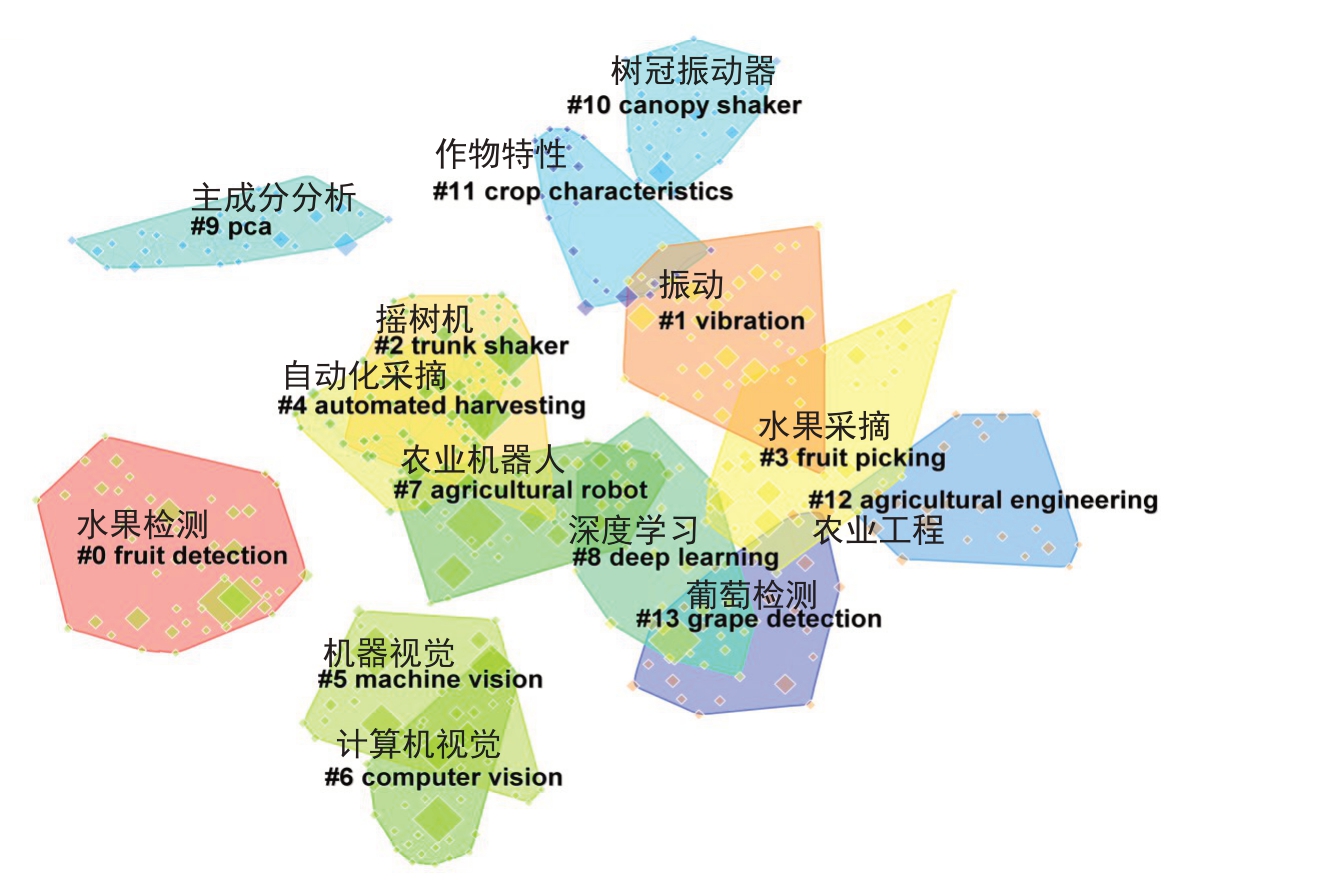
图10 林果收获机械领域关键词聚类分析
Fig.10 Cluster analysis of keywords in the field of fruit harvesting machinery
由图10 可知,关键词聚类形成13 个聚类标签,聚类模块值Q是衡量聚类效果的指标,Q为0.824 4,远高于0.3 的阈值,表明聚类结构具有显著性;平均轮廓值(S)为0.926 8,远超0.7 的可信度阈值,证实了聚类结果的高可靠性和网络同质性。
聚类分析结果显示,研究主题可归纳为两个主要方向:其一,以模块#0(fruit detection)、#5(machine vision)、#6(computer vision)、#8(deep learning)、#9(Pca)和#13(grape detection)为代表的信息技术应用研究,主要聚焦于通过先进信息技术提升机械性能;其二,以模块#1(vibration)、#2(trunk shaker)、#3(fruit picking)、#4(automated harvesting)、#7(agricultural robot)、#10(canopy shaker)、#11(crop characteristics)和#12(agricultural engineering)为核心的实验设计与设备优化研究,重点在于通过机械设计与改进提升生产效率、降低劳动强度。
基于上述分析,笔者在本研究中将领域研究热点归纳为4 个主要方向:(1)收获机械设计与优化;(2)机器视觉技术应用;(3)图像处理算法开发;(4)农业机器人技术创新。
3.3 关键词突现分析
突现词指的是关键词在时间段内出现频次剧增变成热点。采用Kleinberg突现检测算法,通过分析文献题目、摘要、关键词和扩展关键词中抽取突现词,分析他们在不同区间内出现频率的突然变化,识别出代表领域研究前沿的关键词。图11 反映了不同时期研究热点的演变轨迹。
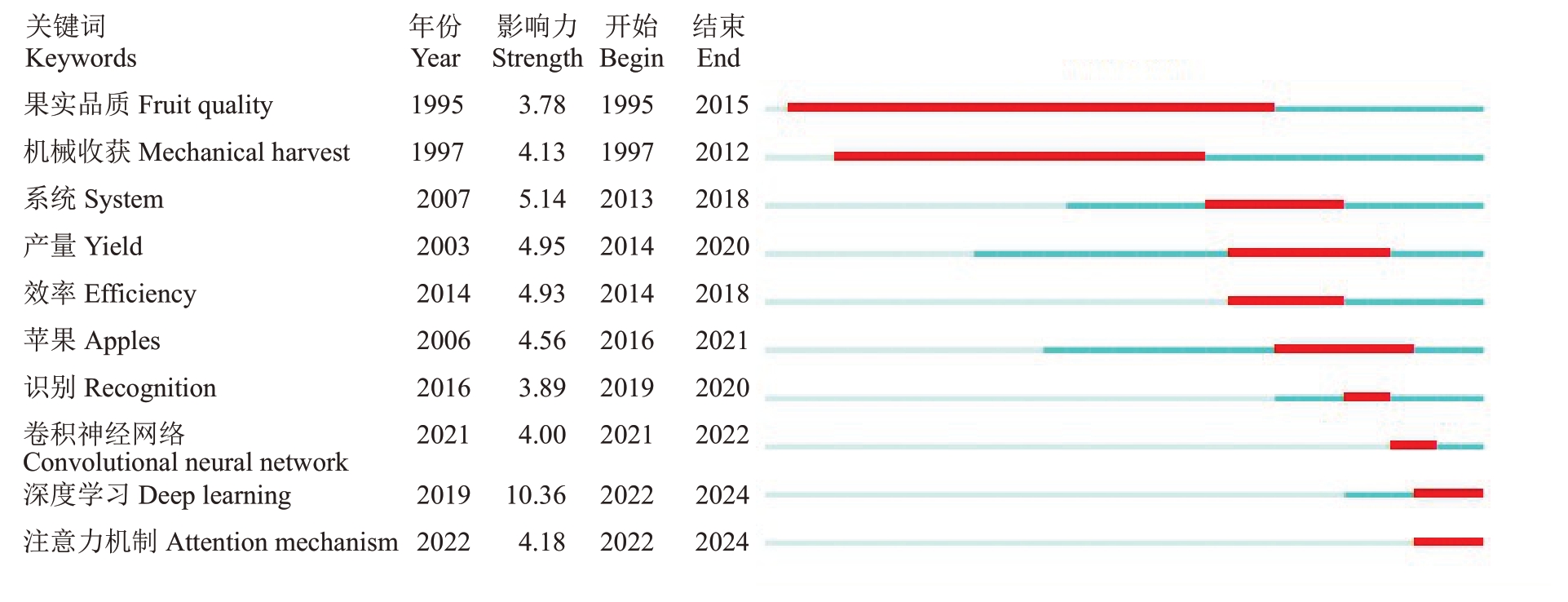
图11 林果收获机械领域TOP 10 关键词突现词
Fig.11 Top 10 keywords with the strongest citation bursts
由图11 可知,图中蓝色线条代表时间间隔,红色线条标识关键词突现的时间跨度。这些突现词代表了研究领域的新兴趋势,应成为学界关注的重点。
从关键词突变强度来看,“fruit quality”和“mechanical harvest”展现出较高的突现强度,表明其持续受到广泛关注。“recognition”在2019—2020 年间显著突现,而“deep learning”和“attention mechanism”则在2022—2024年间快速显现。以Yu等[68]的研究为例,其基于Mask-RCNN 的草莓采摘机器人水果检测研究,通过引入掩码区域卷积神经网络,显著提升了机器视觉在非结构化环境下的目标检测性能。这些趋势表明,林果收获机械研究正呈现逐年加强的态势,且日益重视与信息技术的深度融合。
3.4 关键词时间线分析
使用Citespace 生成1994—2024 年间林果收获机械研究和发展趋势的关键词时间线(图12),通过关键词的变化分析可得出领域的动态发展进程[69]。根据聚类标签颜色变化可明晰各个聚类标签在研究领域的发展时间,不同颜色对应不同年份,冷色调表示距今时间距离更近,暖色调表示距今时间距离更远,时间线较模糊或不存在说明该关键词领域研究暂时中断,出现研究瓶颈,亟待新的改进突破。图12 中每个彩色正方形与圆形节点代表一个前沿热点词汇,节点越大代表该词汇频次越高,受到的关注程度越大,关键词对应时间线上出现其他关键词表明在某段时间里该关键词存在新发展。

图12 关键词时间线
Fig.12 Keyword time line
4 讨 论
林果收获机械领域在近年来涌现出众多引人注目的新研究成果,展现出极为广阔的未来发展前景。
(1)光谱分析[70-72]、图像处理[73]、人工智能[74]等先进技术的融入,促使林果收获机械得以实现自动化操作与智能决策。这一变革不仅显著降低了人工劳动强度,还大幅提升了收获效率与质量。然而,这些技术在数据融合、系统协同等方面的成熟度尚待进一步提升,亟待开展深入研究并予以实现。随着相关技术不断走向成熟且成本逐步降低,其将在更多的林果收获机械中得到广泛应用,进而有力推动整个行业智能化水平的提升。
(2)林果收获机械在应对不同林果品种、种植模式及地形条件时,依然存在一定程度的局限性[75]。因此,研发适应不同林果品种、种植模式和地形条件的收获机械具有重要意义,理应受到高度关注。对于果实形状特殊或生长习性独特的林果品种,现有的采摘机械往往难以高效地进行采摘作业;不同的果树种类以及复杂的地形条件,对收获机械的性能构成了多样化的挑战。故而,深入研究具有较强适应性和灵活性的林果收获机械,对于该领域的发展具有不可忽视的现实意义。
(3)在林果收获机械领域,跨学科合作将成为推动技术创新的关键途径。该领域需与机械工程、电子信息、计算机科学、生物学等多学科展开深度融合,充分发挥各学科的优势,携手攻克一系列技术难题,为整个行业的蓬勃发展提供强劲动力[76]。
未来,技术创新的持续推进、市场需求的不断增长以及政府政策的大力扶持,将共同驱动该领域实现持续发展。在此背景下,该领域的研究人员应紧紧抓住机遇,强化技术创新与市场开拓工作,借助政府政策的扶持,为林果产业的现代化发展贡献更大力量。
5 结 论
笔者在本研究中借助Citespace v6.1.6R 软件,对Web of Science核心数据库中1994—2024年间全球林果收获机械研究领域的相关文献进行了系统梳理,并运用文献计量学方法,对该领域的研究及发展状况展开了客观、科学的分析与探究。通过对近30年文献的剖析可知,该领域的发文量呈现出逐年递增的态势。其中,中国和美国的发文量位居前两位,在林果收获机械研究发展方面贡献突出,在该领域具有较强影响力。然而,在发展过程中仍存在一些问题,如各国之间的合作交流相对较少,尚未形成核心作者团队;在该领域的研究机构中,高校是主要的中坚力量,是推动林果收获机械发展不可或缺的部分。关键词分析结果显示,该领域的主要研究方向为收获机械以及收获机搭载应用技术,研究热点正朝着智能化、自动化和一体化方向发展。具体表现为将光谱分析、图像处理、人工智能等先进技术融入林果收获机械,以实现收获机械的自动化操作与智能决策,进而提升作业精度,增强对不同林果品种、种植模式和地形条件的适应性与灵活性。
[1] WU K S,KONG D Y,YANG X J.The impact of rural industrial development on farmers’livelihoods:Taking fruit-producing area as an example[J].Land,2023,12(8):1478.
[2] BELTON B,WIN M T,ZHANG X B,FILIPSKI M. The rapid rise of agricultural mechanization in Myanmar[J]. Food Policy,2021,101:102095.
[3] ZHOU J F,HE L,ZHANG Q,KARKEE M.Effect of excitation position of a handheld shaker on fruit removal efficiency and damage in mechanical harvesting of sweet cherry[J].Biosystems Engineering,2014,125:36-44.
[4] SANDERS K F. Orange harvesting systems review[J]. Biosystems Engineering,2005,90(2):115-125.
[5] HE L Y,LIU X C,DU X Q,WU C Y. In-situ identification of shaking frequency for adaptive vibratory fruit harvesting[J].Computers and Electronics in Agriculture,2020,170:105245.
[6] HOU J M,HU W X,WANG W,ZHU H J,ZHI R D.Fruit vibration harvesting technology and its damage:A review[J]. INMATEH Agricultural Engineering,2021:155-168.
[7] ZHANG Z,HEINEMANN P H,LIU J,LIU J,BAUGHER T A,SCHUPP J R. The development of mechanical apple harvesting technology:A review[J]. Transactions of the ASABE,2016,59(5):1165-1180.
[8] ZHANG Z,IGATHINATHANE C,LI J,CEN H,LU Y,FLORES P. Technology progress in mechanical harvest of fresh market apples[J]. Computers and Electronics in Agriculture,2020,175:105606.
[9] BORA G C,EHSANI R. Evaluation of a self-propelled citrus fruit pick-up machine[J]. Applied Engineering in Agriculture,2009,25(6):863-868.
[10] 王景巍,王海滨,李志鹏,薛伟,曹国昕.振动式蓝莓采摘机槽型凸轮传动装置的设计与分析[J].东北林业大学学报,2017,45(10):88-93.WANG Jingwei,WANG Haibin,LI Zhipeng,XUE Wei,CAO Guoxin. Design and analysis of grooved cam transmission device of vibrating blueberry picking machine[J].Journal of Northeast Forestry University,2017,45(10):88-93.
[11] 王海滨,李志鹏,姜雪松,聂宏宇,耿雷.基于槽型凸轮传动的蓝莓采摘机设计与试验[J]. 农业机械学报,2018,49(10):80-91.WANG Haibin,LI Zhipeng,JIANG Xuesong,NIE Hongyu,GENG Lei. Design and experiment on blueberry picking machine based on groove cam drive[J].Transactions of the Chinese Society for Agricultural Machinery,2018,49(10):80-91.
[12] WANG J H,LIN X M,LUO L F,CHEN M Y,WEI H L,XU L J,LUO S M.Cognition of grape cluster picking point based on visual knowledge distillation in complex vineyard environment[J].Computers and Electronics in Agriculture,2024,225:109216.
[13] ZHAO J H,YAO X Z,WANG Y,YI Z F,XIE Y M,ZHOU X X. Lightweight-improved YOLOv5s model for grape fruit and stem recognition[J].Agriculture,2024,14(5):774.
[14] MORINAGA K,SUMIKAWA O,KAWAMOTO O,YOSHIKAWA H,NAKAO S,SHIMAZAKI M,KUSABA S N S,HOSHI N. New technologies and systems for high quality citrus fruit production,labor-saving and orchard construction in mountain areas of Japan[J]. Journal of Mountain Science,2005,2(1):59-67.
[15] LI P L,LEE S H,HSU H Y. Review on fruit harvesting method for potential use of automatic fruit harvesting systems[J].Procedia Engineering,2011,23:351-366.
[16] ZHANG J,KANG N B,QU Q J,ZHOU L H,ZHANG H B.Automatic fruit picking technology:A comprehensive review of research advances[J].Artificial Intelligence Review,2024,57(3):54.
[17] WANG D M,HUANGFU Y B,DONG Z J,DONG Y Q. Research hotspots and evolution trends of carbon neutrality:Ⅴisual analysis of bibliometrics based on CiteSpace[J]. Sustainability,2022,14(3):1078.
[18] XU C,YANG T,WANG K,GUO L,LI X M. Knowledge domain and hotspot trends in coal and gas outburst:A scientometric review based on CiteSpace analysis[J]. Environmental Science and Pollution Research,2023,30(11):29086-29099.
[19] MONGEON P,PAUL-HUS A. The journal coverage of web of science and Scopus:A comparative analysis[J]. Scientometrics,2016,106(1):213-228.
[20] ZHU S,MENG H,GU Z J,ZHAO Y L.Research trend of nanoscience and nanotechnology:A bibliometric analysis of Nano Today[J].Nano Today,2021,39:101233.
[21] ERDOǦAN D,GÜNER M,DURSUN E,GEZER İ.Mechanical harvesting of apricots[J]. Biosystems Engineering,2003,85(1):19-28.
[22] YAO P H,QIU L Q,SUN Q,XU L P,ZHAO Y,FAN Z X,ZHANG A D.Designing and testing a picking and selecting integrated remote-operation-type dragon-fruit-picking device[J].Applied Sciences,2024,14(11):4786.
[23] 高自成,李立君,李昕,闵淑辉,易春峰.齿梳式油茶果采摘机采摘执行机构的研制与试验[J].农业工程学报,2013,29(10):19-25.GAO Zicheng,LI Lijun,LI Xin,MIN Shuhui,YI Chunfeng.Development and test of picking actor in oil-tea camellia fruit picking machine of tooth comb type[J]. Transactions of the Chinese Society of Agricultural Engineering,2013,29(10):19-25.
[24] TANG Y C,CHEN M Y,WANG C L,LUO L F,LI J H,LIAN G P,ZOU X J.Recognition and localization methods for visionbased fruit picking robots:A review[J]. Frontiers in Plant Science,2020,11:510.
[25] PALUMBO M,CEFOLA M,PACE B,ATTOLICO G,COLELLI G. Computer vision system based on conventional imaging for non-destructively evaluating quality attributes in fresh and packaged fruit and vegetables[J]. Postharvest Biology and Technology,2023,200:112332.
[26] GANGANAGOWDAR N Ⅴ,GUNDAD A Ⅴ.An intelligent computer vision system for vegetables and fruits quality inspection using soft computing techniques[J].Agricultural Engineering International:CIGR Journal,2019,21(3):171-178.
[27] ANDHARE P,RAWAT S. Pick and place industrial robot controller with computer vision[C]//2016 International Conference on Computing Communication Control and automation (ICCUBEA).August 12-13,2016,Pune,India:IEEE,2016:1-4.
[28] OⅤERBECK Ⅴ,SCHMITZ M,BLANKE M. Non-destructive sensor-based prediction of maturity and optimum harvest date of sweet cherry fruit[J].Sensors,2017,17(2):277.
[29] NEUPANE C,WALSH K B,GOULART R,KOIRALA A. Developing machine vision in tree-fruit applications-fruit count,fruit size and branch avoidance in automated harvesting[J]. Sensors,2024,24(17):5593.
[30] LEE J,NAZKI H,BAEK J,HONG Y,LEE M.Artificial intelligence approach for tomato detection and mass estimation in precision agriculture[J].Sustainability,2020,12(21):9138.
[31] WANG C L,LI C J,HAN Q Y,WU F Y,ZOU X J. A performance analysis of a litchi picking robot system for actively removing obstructions,using an artificial intelligence algorithm[J].Agronomy,2023,13(11):2795.
[32] LIU S C,JIAN Q Y,WEN H Y,CHUNG C H.A crop harvest time prediction model for better sustainability,integrating feature selection and artificial intelligence methods[J]. Sustainability,2022,14(21):14101.
[33] BELOEⅤI,KINANEⅤA D,GEORGIEⅤG,HRISTOⅤG,ZAHARIEⅤP. Artificial intelligence-driven autonomous robot for precision agriculture[J]. Acta Technologica Agriculturae,2021,24(1):48-54.
[34] XIAO X,JIANG Y M,WANG Y N.A method of robot picking citrus based on 3D detection[J]. IEEE Instrumentation & Measurement Magazine,2024,27(3):50-58.
[35] YANG L,CUI B,WU J F,XIAO X,LUO Y,PENG Q M,ZHANG Y L.Automatic detection of banana maturity:Application of image recognition in agricultural production[J]. Processes,2024,12(4):799.
[36] FURMAN J L,PORTER M E,STERN S. The determinants of national innovative capacity[J]. Research Policy,2002,31(6):899-933.
[37] LIN J J,CHEN X.Application of digital design technology in the design of intelligent agricultural machinery and equipment[J].Applied Mathematics and Nonlinear Sciences,2024,9(1):20230215.
[38] 肖荣时. 1999—2020 年我国数字档案馆研究回顾与计量分析[J].兰台世界,2021(1):63-68.XIAO Rongshi. Research review and bibliometric analysis of digital archives in China from 1999 to 2020[J]. Lantai World,2021(1):63-68.
[39] 刘萍萍,厍宇,李海英.基于Citespace 分析中医翻译研究的现状与趋势[J]. 中国中医基础医学杂志,2024,30(2):356-361.LIU Pingping,SHE Yu,LI Haiying.Current status and trends of traditional Chinese medicine translation research based on Citespace analysis[J].Journal of Basic Chinese Medicine,2024,30(2):356-361.
[40] AHMAD S,SOHAIL M,WARIS A,ABDEL-MAGID I M,PATTUKUTHU A,AZAD M S. Evaluating journal quality:A review of journal citation indicators and ranking in library and information science core journals[J]. Collnet Journal of Scientometrics and Information Management,2019,13(2):345-363.
[41] YANG K H,WANG L,YANG G B,JIANG X L. Research hotspots and trends in nursing education from 2014 to 2020:A coword analysis based on keywords[J].Journal of Advanced Nursing,2022,78(3):787-798.
[42] HE Z,MA L,WANG Y C,WEI Y Z,DING X T,LI K,CUI Y J.Double-arm cooperation and implementing for harvesting kiwifruit[J].Agriculture,2022,12(11):1763.
[43] FANIGLIULO R,TOMASONE R. Operative performance and work quality of a hazelnut pick-up machine[J]. Acta Horticulturae,2009,845:425-430.
[44] YUSOFF M Z M,ZAMRI A,ABD KADIR M Z A,HASSAN W W,AZIS N. Structural performance of the integrated oil palm loose fruit collector machine in oil palm plantations[J]. International Journal of Emerging Trends in Engineering Research,2020,8(1.1):193-198.
[45] MUSTAFA M F,HASAN W Z W,HASSAN M S,KADIR M Z A A,AZIS N,YUSOFF M Z M. Structural design of Cartesian vacuum system for loose fruit collector (LFC) machine[C]//2019 IEEE International Circuits and Systems Symposium (ICSyS). September 18- 19,2019. Kuantan,Pahang,Malaysia:IEEE,2019:1-4.
[46] MD SALLEH S,RAHIM E A,GHAZALI I H,AZMI K,JELANI A R,ISMAIL M F,AHMAD M R.Hand-arm vibration analysis of palm oil fruit harvester machine[J].Applied Mechanics and Materials,2013,315:621-625.
[47] PAL A,LEITE A C,FROM P J.A novel end-to-end vision-based architecture for agricultural human-robot collaboration in fruit picking operations[J].Robotics and Autonomous Systems,2024,172:104567.
[48] WEI X Q,JIA K,LAN J H,LI Y W,ZENG Y L,WANG C M.Automatic method of fruit object extraction under complex agricultural background for vision system of fruit picking robot[J].Optik,2014,125(19):5684-5689.
[49] WANG J,CHORTOS A. Control strategies for soft robot systems[J].Advanced Intelligent Systems,2022,4(5):2100165.
[50] ZHAO Y S,GONG L,HUANG Y X,LIU C L.A review of key techniques of vision-based control for harvesting robot[J]. Computers and Electronics in Agriculture,2016,127:311-323.
[51] MAHENDRAN R,JAYASHREE G C,ALAGUSUNDARAM K.Application of computer vision technique on sorting and grading of fruits and vegetables[J]. Journal of Food Processing &Technology,2012,10:2157-7110.
[52] LI Y J,FENG Q C,LI T,XIE F,LIU C,XIONG Z C.Advance of target visual information acquisition technology for fresh fruit robotic harvesting:A review[J].Agronomy,2022,12(6):1336.
[53] GAYATHRI DEⅤI T,NEELAMEGAM P,SUDHA S. Image processing system for automatic segmentation and yield prediction of fruits using open CⅤ[C]//2017 International Conference on Current Trends in Computer,Electrical,Electronics and Communication (CTCEEC). September 8-9,2017,Mysore,India:IEEE,2017:758-762.
[54] XIAO X,WANG Y N,JIANG Y M.End-effectors developed for citrus and other spherical crops[J]. Applied Sciences,2022,12(15):7945.
[55] LI Z Y,YUAN X J,WANG C Y.A review on structural development and recognition-localization methods for end-effector of fruit-vegetable picking robots[J]. International Journal of Advanced Robotic Systems,2022,19(3):17298806221104906.
[56] 王燕,杨庆华,鲍官军,荀一,张立彬.关节型果蔬采摘机械臂优化设计与试验[J].农业机械学报,2011,42(7):191-195.WANG Yan,YANG Qinghua,BAO Guanjun,XUN Yi,ZHANG Libin. Optimization design and experiment of fruit and vegetable picking manipulator[J]. Transactions of the Chinese Society for Agricultural Machinery,2011,42(7):191-195.
[57] 金波,林龙贤.果蔬采摘欠驱动机械手爪设计及其力控制[J].机械工程学报,2014,50(19):1-8.JIN Bo,LIN Longxian. Design and force control of an underactuated robotic hand for fruit and vegetable picking[J]. Journal of Mechanical Engineering,2014,50(19):1-8.
[58] YANG H W,WU J,LIANG A F,WANG S W,YAN Y F,ZHANG H J,LI N,LIU Y Z,WANG J X,QIU J F.Fruit recognition,task plan,and control for apple harvesting robots[J]. Revista Brasileira de Engenharia Agrícola e Ambiental,2024,28(9):e277280.
[59] REZAEI P,HEMMAT A,SHAHPARI N,AHMAD MIREEI S.Machine vision-based algorithms to detect sunburn pomegranate for use in a sorting machine[J]. Measurement,2024,232:114682.
[60] LIU J S,ZHAO G Z,LIU S X,LIU Y,YANG H W,SUN J W,YAN Y F,FAN G Q,WANG J X,ZHANG H J.New progress in intelligent picking:online detection of apple maturity and fruit diameter based on machine vision[J].Agronomy,2024,14(4):721.
[61] LIU T H,WANG X,HU K W,ZHOU H,KANG H W,CHEN C. FF3D:A rapid and accurate 3D fruit detector for robotic harvesting[J].Sensors,2024,24(12):3858.
[62] ZHANG Q,LIU F P,LI B.A heuristic tomato-bunch harvest manipulator path planning method based on a 3D-CNN-based position posture map and rapidly-exploring random tree[J].Computers and Electronics in Agriculture,2023,213:108183.
[63] WANG J,XIA D,WAN J Z,HOU X Y,SHEN G H,LI S S,CHEN H,CUI Q,ZHOU M,WANG J,REN R,HU W,LI J,ZHANG Z Q.Color grading of green Sichuan pepper(Zanthoxylum armatum DC.) dried fruit based on image processing and BP neural network algorithm[J]. Scientia Horticulturae,2024,331:113171.
[64] XU Y,YANG X H,ZHANG J Y,ZHOU X,LUO L W,ZHANG Q.Ⅴisual analysis of sea buckthorn fruit moisture content based on deep image processing technology[J].Food Chemistry,2024,453:139558.
[65] WAKCHAURE G C,NIKAM S B,BARGE K R,KUMAR S,MEENA K K,NAGALKAR ⅤJ,CHOUDHARI J D,KAD ⅤP,REDDY K S. Maturity stages detection prototype device for classifying custard apple (Annona squamosa L.) fruit using image processing approach[J]. Smart Agricultural Technology,2024,7:100394.
[66] YE H R,DU Y,JIN Y T,LIU F Y,HE S S,GUO Y H.Articles on hemorrhagic shock published between 2000 and 2021:A CiteSpace-based bibliometric analysis[J]. Heliyon,2023,9(8):e18840.
[67] TAN H,SUN J H,WANG W J,ZHU C P.User experience&usability of driving:A bibliometric analysis of 2000-2019[J].International Journal of Human-Computer Interaction,2021,37(4):297-307.
[68] YU Y,ZHANG K L,YANG L,ZHANG D X. Fruit detection for strawberry harvesting robot in non-structural environment based on Mask-RCNN[J].Computers and Electronics in Agriculture,2019,163:104846.
[69] SU Z Z,ZHANG C,YAN T Y,ZHU J N,ZENG Y L,LU X J,GAO P,FENG L,HE L H,FAN L H.Application of hyperspectral imaging for maturity and soluble solids content determination of strawberry with deep learning approaches[J]. Frontiers in Plant Science,2021,12:736334.
[70] CANO D Ⅴ,SCHLAM F F H,DE LA O J L R,PRIEGO A F B.‘Ataulfo’mango maturity index prediction using the AS7262 spectral sensor[J].Revista Brasileira de Fruticultura,2024,46:e-48.
[71] SUN M M,JIANG H Z,YUAN W D,JIN S X,ZHOU H P,ZHOU Y,ZHANG C. Discrimination of maturity of Camellia oleifera fruit on-site based on generative adversarial network and hyperspectral imaging technique[J]. Journal of Food Measurement and Characterization,2024,18(1):10-25.
[72] ALAAUDEEN K M,SELⅤARAJAN S,MANOHARAN H,JHAⅤERI R H. Intelligent robotics harvesting system process for fruits grasping prediction[J].Scientific Reports,2024,14(1):2820.
[73] CHU P Y,LI Z J,ZHANG K X,LAMMERS K,LU R F. Highprecision fruit localization using active laser-camera scanning:Robust laser line extraction for 2D-3D transformation[J]. Smart Agricultural Technology,2024,7:100391.
[74] FERNÁNDEZ R,SALINAS C,MONTES H,SARRIA J.Multisensory system for fruit harvesting robots. Experimental testing in natural scenarios and with different kinds of crops[J]. Sensors,2014,14(12):23885-23904.
[75] KALEEM A,HUSSAIN S,AQIB M,CHEEMA M J M,SALEEM S R,FAROOQ U. Development challenges of fruit-harvesting robotic arms:A critical review[J]. AgriEngineering,2023,5(4):2216-2237.
[76] XIAO F,WANG H B,XU Y Q,ZHANG R Q. Fruit detection and recognition based on deep learning for automatic harvesting:An overview and review[J].Agronomy,2023,13(6):1625.